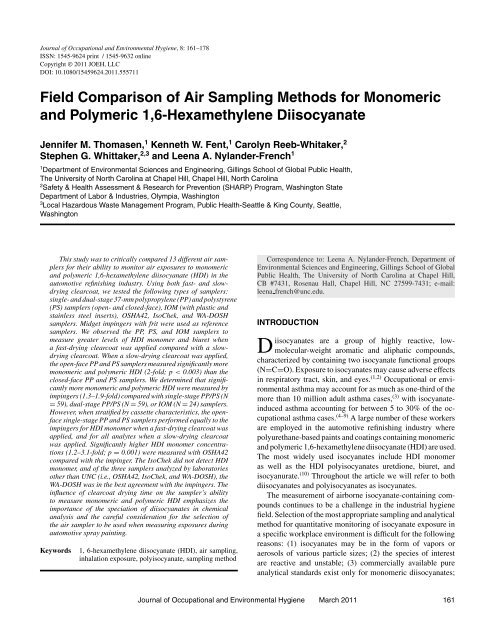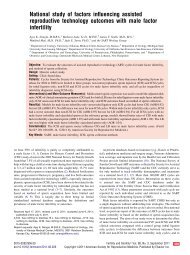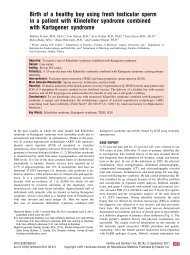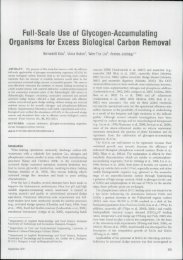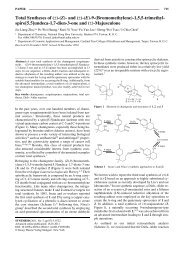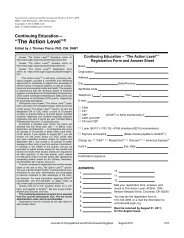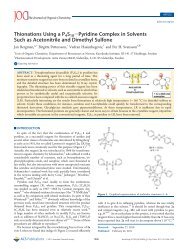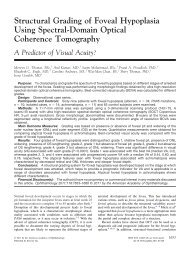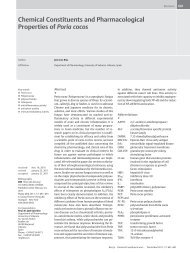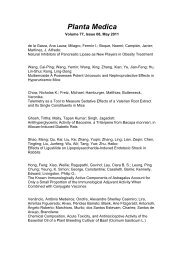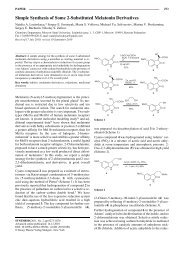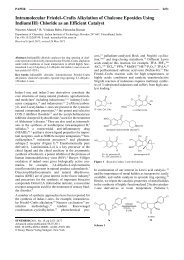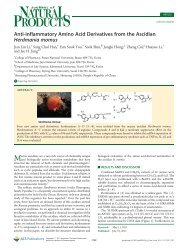Field Comparison of Air Sampling Methods for Monomeric and ...
Field Comparison of Air Sampling Methods for Monomeric and ...
Field Comparison of Air Sampling Methods for Monomeric and ...
Create successful ePaper yourself
Turn your PDF publications into a flip-book with our unique Google optimized e-Paper software.
Journal <strong>of</strong> Occupational <strong>and</strong> Environmental Hygiene, 8: 161–178<br />
ISSN: 1545-9624 print / 1545-9632 online<br />
Copyright c○ 2011 JOEH, LLC<br />
DOI: 10.1080/15459624.2011.555711<br />
<strong>Field</strong> <strong>Comparison</strong> <strong>of</strong> <strong>Air</strong> <strong>Sampling</strong> <strong>Methods</strong> <strong>for</strong> <strong>Monomeric</strong><br />
<strong>and</strong> Polymeric 1,6-Hexamethylene Diisocyanate<br />
Jennifer M. Thomasen, 1 Kenneth W. Fent, 1 Carolyn Reeb-Whitaker, 2<br />
Stephen G. Whittaker, 2,3 <strong>and</strong> Leena A. Nyl<strong>and</strong>er-French 1<br />
1 Department <strong>of</strong> Environmental Sciences <strong>and</strong> Engineering, Gillings School <strong>of</strong> Global Public Health,<br />
The University <strong>of</strong> North Carolina at Chapel Hill, Chapel Hill, North Carolina<br />
2 Safety & Health Assessment & Research <strong>for</strong> Prevention (SHARP) Program, Washington State<br />
Department <strong>of</strong> Labor & Industries, Olympia, Washington<br />
3 Local Hazardous Waste Management Program, Public Health-Seattle & King County, Seattle,<br />
Washington<br />
This study was to critically compared 13 different air samplers<br />
<strong>for</strong> their ability to monitor air exposures to monomeric<br />
<strong>and</strong> polymeric 1,6-hexamethylene diisocyanate (HDI) in the<br />
automotive refinishing industry. Using both fast- <strong>and</strong> slowdrying<br />
clearcoat, we tested the following types <strong>of</strong> samplers:<br />
single- <strong>and</strong> dual-stage 37-mm polypropylene (PP) <strong>and</strong> polystyrene<br />
(PS) samplers (open- <strong>and</strong> closed-face), IOM (with plastic <strong>and</strong><br />
stainless steel inserts), OSHA42, IsoChek, <strong>and</strong> WA-DOSH<br />
samplers. Midget impingers with frit were used as reference<br />
samplers. We observed the PP, PS, <strong>and</strong> IOM samplers to<br />
measure greater levels <strong>of</strong> HDI monomer <strong>and</strong> biuret when<br />
a fast-drying clearcoat was applied compared with a slowdrying<br />
clearcoat. When a slow-drying clearcoat was applied,<br />
the open-face PP <strong>and</strong> PS samplers measured significantly more<br />
monomeric <strong>and</strong> polymeric HDI (2-fold; p < 0.003) than the<br />
closed-face PP <strong>and</strong> PS samplers. We determined that significantly<br />
more monomeric <strong>and</strong> polymeric HDI were measured by<br />
impingers (1.3–1.9-fold) compared with single-stage PP/PS (N<br />
= 59), dual-stage PP/PS (N = 59), or IOM (N = 24) samplers.<br />
However, when stratified by cassette characteristics, the openface<br />
single-stage PP <strong>and</strong> PS samplers per<strong>for</strong>med equally to the<br />
impingers <strong>for</strong> HDI monomer when a fast-drying clearcoat was<br />
applied, <strong>and</strong> <strong>for</strong> all analytes when a slow-drying clearcoat<br />
was applied. Significantly higher HDI monomer concentrations<br />
(1.2–3.1-fold; p = 0.001) were measured with OSHA42<br />
compared with the impinger. The IsoChek did not detect HDI<br />
monomer, <strong>and</strong> <strong>of</strong> the three samplers analyzed by laboratories<br />
other than UNC (i.e., OSHA42, IsoChek, <strong>and</strong> WA-DOSH), the<br />
WA-DOSH was in the best agreement with the impingers. The<br />
influence <strong>of</strong> clearcoat drying time on the sampler’s ability<br />
to measure monomeric <strong>and</strong> polymeric HDI emphasizes the<br />
importance <strong>of</strong> the speciation <strong>of</strong> diisocyanates in chemical<br />
analysis <strong>and</strong> the careful consideration <strong>for</strong> the selection <strong>of</strong><br />
the air sampler to be used when measuring exposures during<br />
automotive spray painting.<br />
Keywords 1, 6-hexamethylene diisocyanate (HDI), air sampling,<br />
inhalation exposure, polyisocyanate, sampling method<br />
Correspondence to: Leena A. Nyl<strong>and</strong>er-French, Department <strong>of</strong><br />
Environmental Sciences <strong>and</strong> Engineering, Gillings School <strong>of</strong> Global<br />
Public Health, The University <strong>of</strong> North Carolina at Chapel Hill,<br />
CB #7431, Rosenau Hall, Chapel Hill, NC 27599-7431; e-mail:<br />
leena french@unc.edu.<br />
INTRODUCTION<br />
Diisocyanates are a group <strong>of</strong> highly reactive, lowmolecular-weight<br />
aromatic <strong>and</strong> aliphatic compounds,<br />
characterized by containing two isocyanate functional groups<br />
(N=C=O). Exposure to isocyanates may cause adverse effects<br />
in respiratory tract, skin, <strong>and</strong> eyes. (1,2) Occupational or environmental<br />
asthma may account <strong>for</strong> as much as one-third <strong>of</strong> the<br />
more than 10 million adult asthma cases, (3) with isocyanateinduced<br />
asthma accounting <strong>for</strong> between 5 to 30% <strong>of</strong> the occupational<br />
asthma cases. (4–9) A large number <strong>of</strong> these workers<br />
are employed in the automotive refinishing industry where<br />
polyurethane-based paints <strong>and</strong> coatings containing monomeric<br />
<strong>and</strong> polymeric 1,6-hexamethylene diisocyanate (HDI) are used.<br />
The most widely used isocyanates include HDI monomer<br />
as well as the HDI polyisocyanates uretdione, biuret, <strong>and</strong><br />
isocyanurate. (10) Throughout the article we will refer to both<br />
diisocyanates <strong>and</strong> polyisocyanates as isocyanates.<br />
The measurement <strong>of</strong> airborne isocyanate-containing compounds<br />
continues to be a challenge in the industrial hygiene<br />
field. Selection <strong>of</strong> the most appropriate sampling <strong>and</strong> analytical<br />
method <strong>for</strong> quantitative monitoring <strong>of</strong> isocyanate exposure in<br />
a specific workplace environment is difficult <strong>for</strong> the following<br />
reasons: (1) isocyanates may be in the <strong>for</strong>m <strong>of</strong> vapors or<br />
aerosols <strong>of</strong> various particle sizes; (2) the species <strong>of</strong> interest<br />
are reactive <strong>and</strong> unstable; (3) commercially available pure<br />
analytical st<strong>and</strong>ards exist only <strong>for</strong> monomeric diisocyanates;<br />
Journal <strong>of</strong> Occupational <strong>and</strong> Environmental Hygiene March 2011 161
<strong>and</strong> (4) low limits <strong>of</strong> detection are needed. (11,12) Use <strong>of</strong> an<br />
appropriate sampling <strong>and</strong>/or analytical method is critical <strong>for</strong><br />
accurate assessment <strong>of</strong> worker’s exposure to isocyanates. Most<br />
<strong>of</strong> the exposure assessment studies evaluating airborne isocyanate<br />
exposure in the automotive refinishing industry have<br />
used a variety <strong>of</strong> air sampling devices <strong>and</strong> analytical methods,<br />
there<strong>for</strong>e making it challenging to compare the results. (13–18)<br />
In the spray painting environment, monomeric <strong>and</strong> polymeric<br />
HDI are present in both aerosol <strong>and</strong> vapor phases. (19)<br />
Several sampling devices <strong>and</strong> analytical chemistry methods<br />
have been used <strong>for</strong> the measurement <strong>and</strong> analysis <strong>of</strong><br />
monomeric <strong>and</strong> polymeric HDI present in both the aerosol<br />
<strong>and</strong> vapor phases. Some common sampling devices include<br />
a variety <strong>of</strong> cassettes with treated filters, such as Institute<br />
<strong>of</strong> Medicine (IOM) sampler, Occupational Safety <strong>and</strong> Health<br />
Administration Method 42 (OSHA42) sampler, <strong>and</strong> IsoChek<br />
sampler, as well as impingers or bubblers filled with absorbing<br />
solution.<br />
Both single-stage <strong>and</strong> dual-stage filter cassettes have been<br />
used to sample isocyanates in the occupational setting. (20)<br />
The dual-stage samplers typically contain a first stage that is<br />
loaded with an untreated polytetrafluoroethylene (PTFE) prefilter<br />
(designed to collect isocyanate aerosols), <strong>and</strong> the second<br />
stage is loaded with a glass fiber filter (GFF) impregnated<br />
with a derivatizing agent (designed to collect <strong>and</strong> derivatize<br />
isocyanate vapors). With single-stage sampling, a PTFE filter<br />
is not used, <strong>and</strong> as a result, the impregnated GFF collects <strong>and</strong><br />
derivatizes isocyanates in both aerosol <strong>and</strong> vapor phases.<br />
A commonly used single-stage sampling method is<br />
OSHA42, (21) which utilizes a GFF impregnated with 1-(2pyridyl)<br />
piperazine (1-2PP) to sample diisocyanate monomer.<br />
A commonly used dual-stage sampler is IsoChek (Omega<br />
Specialty Instrument Co., Houston, Texas), which employs<br />
9-(N-methylaminomethyl)anthracene (MAMA) <strong>for</strong> derivatization.<br />
The analytical method provided by the commercially<br />
available IsoChek reports diisocyanate monomer as well as<br />
all polyisocyanates expressed as total reactive isocyanates<br />
(TRIG). TRIG is defined as the sum <strong>of</strong> free NCO groups<br />
(i.e., comprising all isocyanate species) present in a sample. (22)<br />
However, this is a subjective definition that is dependent on<br />
the analytical scheme used to define total NCO. In addition,<br />
there are several impinger methods (e.g., NIOSH 5521, NIOSH<br />
5522, proposed NIOSH 5525), which have been modified <strong>for</strong><br />
single-stage filter sampling <strong>of</strong> isocyanates.<br />
Several studies (11,12,18,19,22–28) have been per<strong>for</strong>med to evaluate<br />
<strong>and</strong> compare some <strong>of</strong> these sampler types. However, the<br />
evidence is inconclusive regarding the suitability <strong>and</strong> accuracy<br />
<strong>of</strong> these methods <strong>for</strong> monitoring isocyanate exposure<br />
in different settings. There<strong>for</strong>e, the objective <strong>of</strong> this study<br />
was to compare sampling devices commonly used to quantify<br />
exposure to monomeric <strong>and</strong> polymeric HDI in the spray painting<br />
environment. Our ability to measure isocyanate exposure<br />
properly is critical <strong>for</strong> exposure <strong>and</strong> risk assessment to predict<br />
systemic exposure, to develop sensitive <strong>and</strong> predictive models<br />
through multiple exposure routes, <strong>and</strong> ultimately to protect the<br />
health <strong>of</strong> workers.<br />
METHODS<br />
<strong>Air</strong> Samplers<br />
A total <strong>of</strong> 13 air samplers were compared <strong>for</strong> measuring<br />
monomeric <strong>and</strong> polymeric HDI levels. Along with glass<br />
midget impingers with frit (reference sampler), we evaluated<br />
the per<strong>for</strong>mance <strong>of</strong> single- <strong>and</strong> dual-stage 37-mm polypropylene<br />
(PP) <strong>and</strong> polystyrene (PS) samplers either open- or closedface,<br />
<strong>and</strong> IOM samplers with plastic <strong>and</strong> stainless steel inserts,<br />
as well as OSHA42, IsoChek, <strong>and</strong> Washington State Division<br />
<strong>of</strong> Safety <strong>and</strong> Health (WA-DOSH) samplers. These samplers<br />
were selected because they have previously been used to<br />
monitor monomeric <strong>and</strong> polymeric HDI exposures in research<br />
studies as well as by practicing industrial hygienists <strong>for</strong> regulatory<br />
purposes. We decided to include both PP <strong>and</strong> PS materials<br />
because we found lower recoveries <strong>of</strong> HDI <strong>for</strong> PS as compared<br />
with PP in laboratory experiments (results not published),<br />
which supported Huynh et al. (29) findings that showed higher<br />
recovery from PP cassettes. The different samplers are described<br />
below <strong>and</strong> further summarized in Table I. All chemicals<br />
used in this study were obtained from Sigma Aldrich (St.<br />
Louis, Mo.) unless otherwise specified. All samplers analyzed<br />
at UNC laboratory were prepared no more than 2 weeks prior<br />
to sampling.<br />
Single- <strong>and</strong> Dual-Stage PP <strong>and</strong> PS Samplers<br />
The single-stage PP <strong>and</strong> PS samplers contained a 37-mm<br />
GFF (Type AE; SKC, Eighty Four, Pa.) impregnated with<br />
MPP solution [1-(2-methoxyphenyl)-piperazine (MPP), 192.3<br />
g/mol; 1.09 g/mL in toluene] designed to collect <strong>and</strong> derivatize<br />
isocyanate vapors. The dual-stage PP <strong>and</strong> PS samplers contained<br />
an untreated polytetrafluoroethylene (PTFE) pre-filter,<br />
designed to collect isocyanate aerosols, <strong>and</strong> an impregnated<br />
GFF. Be<strong>for</strong>e GFFs were placed into a single- or dual-cassette<br />
housing, they were impregnated with 400 µL <strong>of</strong> 12 g/L MPP<br />
in toluene, which corresponds to 4.8 mg <strong>of</strong> MPP, <strong>and</strong> then<br />
allowed to dry <strong>for</strong> 15 min.<br />
IOM Samplers<br />
IOM samplers with either stainless steel or plastic insert<br />
were prepared by impregnating a 25-mm GFF (SKC) with<br />
400 µL MPP solution, which corresponds to 4.8 mg <strong>of</strong> MPP<br />
(consistent with PP/PS samplers). Be<strong>for</strong>e placing the GFF into<br />
a sampler, 200 µL <strong>of</strong> 12 g/L MPP in toluene was applied to the<br />
filter <strong>and</strong> allowed to dry <strong>for</strong> 15 min, after which an additional<br />
200 µL <strong>of</strong> 12 g/L MPP in toluene was applied <strong>and</strong> allowed to<br />
dry <strong>for</strong> 15 min.<br />
OSHA42<br />
A 37-mm GFF was coated with 0.1 mg <strong>of</strong> 1-(2-pyridyl)<br />
piperazine (1–2PP) <strong>and</strong> housed in a PS cassette. These samplers<br />
(Galson Laboratories, Syracuse, N.Y.) were used to monitor<br />
concentrations <strong>of</strong> HDI monomer.<br />
162 Journal <strong>of</strong> Occupational <strong>and</strong> Environmental Hygiene March 2011
TABLE I. Summary <strong>of</strong> Samplers, Experimental Conditions, <strong>and</strong> Analytical Techniques<br />
Dual-Stage<br />
WA-DOSH<br />
Dual-Stage<br />
IsoChek<br />
Single-Stage<br />
OSHA42<br />
Impinger Single-Stage Dual-Stage IOM<br />
37-mm PS 37-mm PS 37-mm PS<br />
37-mm PP or PS 37-mm PP or PS 25-mm SS<br />
or plastic<br />
Housing 25-mL midget<br />
impinger with<br />
frit<br />
Housing Mode NA Open- or closed-face Open- or closed-face Open-face Open-face Closed-face Closed-face<br />
Sample Medium 15 mL <strong>of</strong> 2 g/L GFF with MPP 5 µm PTFE GFF with MPP GFF with 1-2PP 5 µm PTFE 5 µm PTFE<br />
MPP in 30% (4.8 mg)<br />
GFF with MPP (4.8 mg) (0.1 mg) GFF with GFF with<br />
DMF/ACN<br />
(4.8 mg)<br />
MAMA (0.1 mg) MAMA<br />
(30 mg)<br />
(0.1 mg)<br />
Flow Rate 1 L/min 1 L/min 1 L/min 2 L/min 1 L/min 1 L/min 1 L/min<br />
Analyte HDI monomer HDI monomer HDI monomer HDI monomer HDI monomer HDI monomer HDI monomer<br />
HDI HDI HDI HDI HDI HDI<br />
polyisocyanates polyisocyanates polyisocyanates polyisocyanates<br />
polyisocyanates polyisocyanates<br />
(biuret <strong>and</strong> (biuret <strong>and</strong> (biuret <strong>and</strong> (biuret <strong>and</strong><br />
(total NCO) (biuret <strong>and</strong><br />
isocyanurate) isocyanurate) isocyanurate) isocyanurate)<br />
isocyanurate)<br />
Analytical LC-MS LC-MS LC-MS LC-MS HPLC-UV or FL HPLC-PDA UV HPLC-DAD<br />
<strong>and</strong> FLD<br />
monomer 0.005<br />
biuret 1.7<br />
isocyanurate 1.2<br />
0.1B monomer <strong>and</strong><br />
polyisocyanate<br />
0.03B monomer 0.002<br />
biuret 0.02<br />
isocyanurate<br />
0.02<br />
monomer 0.002<br />
biuret 0.02<br />
isocyanurate 0.02<br />
monomer 0.002<br />
biuret 0.02<br />
isocyanurate 0.02<br />
Technique<br />
LODA (µg) monomer 0.002<br />
biuret 0.02<br />
isocyanurate<br />
0.02<br />
Notes: PP = polypropylene; PS = polystyrene; SS = stainless steel; NA = not applicable; MPP = 1-(2-methoxyphenyl)-piperazine; DMF = N,N-dimethyl<strong>for</strong>mamide; ACN = acetonitrile; GFF = glass fiber<br />
filter; PTFE = polytetrafluoroethylene; 1-2PP = 1-(2-pyridyl) piperazine; MAMA = 9-(N-methylaminomethyl)anthracene; LC-MS = liquid chromatography/mass spectrometry; HPLC = high-per<strong>for</strong>mance<br />
liquid chromatography; UV = ultraviolet detector; FL = fluorescence detector; PDA = photodiode array detector; DAD = diode array detector.<br />
AInstrumental limit <strong>of</strong> detection: µg per filter.<br />
Journal <strong>of</strong> Occupational <strong>and</strong> Environmental Hygiene March 2011 163<br />
B Based on limit <strong>of</strong> quantitation (reporting limit) provided by accredited laboratory.
IsoChek<br />
This sampler was a dual-stage, 37-mm PS cassette (Galson).<br />
The first stage included a 5-µm PTFE filter designed to<br />
capture aerosols, while the second stage included a 37-mm<br />
GFF impregnated with 9-(N-methylaminomethyl)anthracene<br />
(MAMA) designed to capture <strong>and</strong> derivatize isocyanate vapors.<br />
WA-DOSH<br />
The WA-DOSH sampler uses the same dual-stage cassette,<br />
filters, <strong>and</strong> derivatizing agents as the commercially available<br />
IsoChek sampler described above. A different analytical technique<br />
is utilized <strong>for</strong> the analysis <strong>of</strong> the WA-DOSH sampler by<br />
the Washington State DOSH laboratory, an AIHA-accredited<br />
laboratory. The WA-DOSH Labor <strong>and</strong> Industry (L&I) method<br />
directly measures the mass <strong>of</strong> individual diisocyanate polymers<br />
<strong>and</strong> expresses each diisocyanate in units <strong>of</strong> µg/m 3 .<br />
Impinger<br />
Glass midget impingers with frit (SKC 225-36-2) were<br />
filled with 15 mL <strong>of</strong> derivatizing solution that was made by<br />
dissolving 2 g <strong>of</strong> MPP in 1 L <strong>of</strong> 30% v/v solution <strong>of</strong> N,Ndimethyl<strong>for</strong>mamide<br />
(DMF, 73.09 g/mol) in acetonitrile (ACN,<br />
41.05 g/mol). The theoretical amount <strong>of</strong> derivatizing agent<br />
(MPP) in each impinger was 30 mg.<br />
Spray Painting Procedure <strong>and</strong> Sample Collection<br />
As shown in Figure 1, six samplers (A–F) <strong>of</strong> the same<br />
type <strong>and</strong> three impingers (I1–I3) were attached to a cardboard<br />
backing. The samplers were attached to a high-flow<br />
pump (SKC) operated at 1 or 2 L/min. The pumps were<br />
calibrated be<strong>for</strong>e <strong>and</strong> after sampling using a DryCal (BIOS<br />
Corp., Butler, N.J.) primary flow meter. Clearcoat was sprayed<br />
directly above the samplers with a high-volume, low-pressure<br />
(HVLP) spray gun, producing an overspray that was deposited<br />
over the samplers. The same painter was used throughout the<br />
study <strong>and</strong> was instructed to st<strong>and</strong> approximately 1 m from the<br />
samplers. The painter sprayed the clearcoat over the top <strong>of</strong><br />
the samplers across the cardboard backing four times during<br />
each spray period. Spraying was conducted a total <strong>of</strong> three<br />
times throughout the 15-min sample period (once every 5 min)<br />
using a multi-use clear with either HDI-containing fast or slow<br />
activator-reducer (3:1 clear to activator by volume). For quality<br />
control, blank sample controls were obtained by opening <strong>and</strong><br />
closing prepared cassettes in the field setting. In addition, bulk<br />
samples (10 µL) <strong>of</strong> the clearcoat being sprayed were collected<br />
each time a new batch <strong>of</strong> clearcoat was mixed (N = 12).<br />
Sample Processing <strong>and</strong> Analysis<br />
PP, PS, <strong>and</strong> IOM Samplers<br />
Immediately after sampling, both the PTFE <strong>and</strong> GFF from<br />
single- <strong>and</strong> dual-stage PP <strong>and</strong> PS, as well as from IOM cassettes,<br />
were placed into 20-mL glass vials (I-Chem, Thermo<br />
Fisher Scientific, Rockwood, Tenn.) containing 5 mL <strong>of</strong> derivatizing<br />
solution (2 g/L MPP in 30% DMF-ACN solution) to<br />
minimize the time <strong>for</strong> any competing reactions, such as isocyanate<br />
polymerization. Samples were shaken thoroughly <strong>and</strong><br />
then stored in a cooler (∼4 ◦ C) until returned to our laboratory<br />
at UNC <strong>and</strong> stored at –40 ◦ C until analyzed. For analysis,<br />
samples were returned to room temperature, <strong>and</strong> acetic anhydride<br />
was added (100 µL) to acetylate residual MPP. After<br />
15 min, internal st<strong>and</strong>ard (52 pmol/µL 1,8-octamethylene<br />
diisocyanate; ODIU) was added (100 µL) to give an internal<br />
st<strong>and</strong>ard concentration <strong>of</strong> 1 pmol/µL. Samples were analyzed<br />
<strong>for</strong> HDI monomer, biuret, <strong>and</strong> isocyanurate using liquid<br />
chromatography-mass spectrometry (LC-MS) as described<br />
elsewhere. (30)<br />
OSHA42<br />
Samples were h<strong>and</strong>led according to manufacturer’s specifications.<br />
After sampling, the cassettes with GFFs in place<br />
were sealed <strong>and</strong> stored at –40 ◦ C until shipment in a cooler<br />
(∼4 ◦ C) to Galson Laboratories (an AIHA-accredited laboratory)<br />
<strong>for</strong> analysis. Samples were processed <strong>and</strong> analyzed<br />
<strong>for</strong> HDI monomer by OSHA42 method, which utilizes solvent<br />
desorption <strong>and</strong> high-per<strong>for</strong>mance liquid chromatography<br />
(HPLC) analysis using ultraviolet (UV) or fluorescence (FL)<br />
detector. (21)<br />
IsoChek<br />
Samples were h<strong>and</strong>led according to the manufacturer’s<br />
specifications. After sampling, the PTFE filter was immediately<br />
placed into 5 mL <strong>of</strong> methoxy-2-phenyl-1-piperazine<br />
reagent (MOPIP) in toluene (0.1 mg/mL) to derivatize<br />
aerosols. The vials containing PTFE filters <strong>and</strong> the cassettes<br />
with GFFs in place were sealed <strong>and</strong> stored at –40 ◦ C until shipment<br />
in a cooler (∼4 ◦ C) to Galson Laboratories <strong>for</strong> analysis.<br />
Both the PTFE filters <strong>and</strong> GFFs were analyzed using HPLC<br />
with photodiode array detector (PDA) UV <strong>for</strong> HDI monomer<br />
<strong>and</strong> polyisocyanates. The IsoChek method does not identify<br />
the types <strong>of</strong> polyisocyanates present based on specific<br />
polyisocyanate st<strong>and</strong>ards. Instead, polyisocyanates <strong>of</strong> HDI are<br />
identified by comparing a diode array scan <strong>of</strong> the associated<br />
monomer st<strong>and</strong>ard with a diode array scan <strong>of</strong> the samples to<br />
identify the presence <strong>of</strong> polyisocyanate peaks. Once identified,<br />
the areas <strong>of</strong> these peaks are summed <strong>and</strong> quantified using<br />
the response factor <strong>of</strong> the monomer peak <strong>and</strong> concentration<br />
calculated using the molecular weight <strong>of</strong> an NCO equivalent<br />
(42 g/mol).<br />
WA-DOSH<br />
Samples were h<strong>and</strong>led according to the WA-DOSH L&I<br />
method specifications (L&I 0050 <strong>and</strong> L&I 0067). After sampling<br />
was completed, the PTFE filter was immediately removed<br />
from the cassette <strong>and</strong> placed in a jar with 4 mL <strong>of</strong><br />
MOPIP in toluene solution (1 mg/mL), <strong>and</strong> the cassettes with<br />
GFFs in place were sealed. The samples were stored at –40 ◦ C<br />
until analysis by WA-DOSH state laboratory using HPLC<br />
with diode array detector (DAD) <strong>and</strong> FL UV as described<br />
in WA-DOSH L&I methods 0050 <strong>and</strong> 0067. (31,32) The WA-<br />
DOSH L&I method directly measures the mass <strong>of</strong> individual<br />
164 Journal <strong>of</strong> Occupational <strong>and</strong> Environmental Hygiene March 2011
FIGURE 1. Sampler setup during spray painting (I1 = reference Impinger 1 compared with Samplers A <strong>and</strong> B; I2 = reference Impinger 2<br />
compared with Samplers C <strong>and</strong> D; I3 = reference Impinger 3 compared with Samplers E <strong>and</strong> F).<br />
diisocyanate polymers <strong>and</strong> expresses each diisocyanate in units<br />
<strong>of</strong> µg/m 3 .<br />
Impingers<br />
After sample collection, the solution evaporated from the<br />
impinger during sampling was replaced with derivatizing solution<br />
(2 g/L MPP in 30% DMF/ACN) to obtain a total volume<br />
<strong>of</strong> 15 mL. The sampling solution was then transferred into<br />
a 20-mL glass vial (I-Chem) <strong>and</strong> placed in a cooler (∼4 ◦ C)<br />
<strong>and</strong> returned to our laboratory at UNC <strong>for</strong> storage at –40 ◦ C<br />
until analyzed. For analysis, samples were returned to room<br />
temperature, <strong>and</strong> acetic anhydride was added (200 µL) to<br />
acetylate residual MPP. After 15 min, internal st<strong>and</strong>ard (77<br />
pmol/µL ODIU) was added (200 µL) to give an internal<br />
st<strong>and</strong>ard concentration <strong>of</strong> 1 pmol/µL. Samples were analyzed<br />
using LC-MS as described elsewhere. (30)<br />
Bulk Samples<br />
Bulk sample <strong>of</strong> a mixed clearcoat (10 µL) was drawn into<br />
a 20-µL pipette <strong>and</strong> dispensed into a glass vial (I-Chem)<br />
filled with 15 mL <strong>of</strong> derivatizing solution (2 g/L MPP in<br />
30% DMF/ACN). The pipette tip was also ejected into the<br />
solution to eliminate sidewall losses due to the viscosity <strong>of</strong><br />
the clearcoat. The samples were then placed into a cooler<br />
(∼4 ◦ C) <strong>and</strong> returned to our laboratory at UNC <strong>for</strong> storage at<br />
–40 ◦ C until analyzed. For analysis, samples were returned to<br />
room temperature, <strong>and</strong> acetic anhydride was added (200 µL)<br />
to acetylate residual MPP. After 15 min, internal st<strong>and</strong>ard (2<br />
pmol/µL ODIU) was combined (1:1 v/v ratio) with aliquots <strong>of</strong><br />
each paint sample to give an internal st<strong>and</strong>ard concentration <strong>of</strong><br />
1 pmol/µL. Samples were analyzed using LC-MS as described<br />
elsewhere. (30)<br />
Data Analysis<br />
The relative st<strong>and</strong>ard error (RSE) <strong>and</strong> relative st<strong>and</strong>ard<br />
deviation (RSD) <strong>for</strong> the three impinger samples <strong>and</strong> six cassette<br />
samples collected during each sampling run were calculated.<br />
We further calculated an overall mean RSE <strong>and</strong> RSD among<br />
the sampling runs <strong>for</strong> both fast- <strong>and</strong> slow-drying clearcoats.<br />
Paired t-test (α-level <strong>of</strong> 0.05) was used to determine if the<br />
variability among impingers <strong>and</strong> cassette samplers was significantly<br />
different.<br />
PP, PS, <strong>and</strong> IOM Samplers<br />
For dual-stage samplers, the sum <strong>of</strong> the mass on the filters<br />
(PTFE <strong>and</strong> GFF) was calculated. Levels below the limit <strong>of</strong><br />
detection (LOD) or limit <strong>of</strong> quantitation (LOQ) were assigned<br />
values by dividing the respective limits by √ 2. (33) The ratio<br />
<strong>of</strong> the HDI concentration in the filter(s) to the concentration<br />
measured with the impinger was determined, <strong>and</strong> the<br />
ratios were natural log-trans<strong>for</strong>med to satisfy the normality assumption.<br />
Shapiro-Wilks tests <strong>for</strong> normality indicated that the<br />
ratios were approximately log-normally distributed <strong>for</strong> HDI<br />
Journal <strong>of</strong> Occupational <strong>and</strong> Environmental Hygiene March 2011 165
monomer (W = 0.99), biuret (W = 0.95), <strong>and</strong> isocyanurate<br />
(W = 0.96).<br />
The data were analyzed using SAS 9.1 statistical s<strong>of</strong>tware<br />
(SAS Institute, Cary, N.C.) at α-level <strong>of</strong> 0.05. A paired t-test<br />
was used to determine if samplers were significantly different<br />
from the adjacent impinger samples. General linear modeling<br />
(SAS PROC GLM) with the least squares approach was used<br />
to investigate the differences in the measured amounts <strong>of</strong><br />
HDI monomer, biuret, <strong>and</strong> isocyanurate between the samplers.<br />
GLM analysis <strong>of</strong> covariance (ANCOVA) type III sum <strong>of</strong><br />
squares, with adjustment <strong>for</strong> reference impinger, was utilized<br />
to determine if the variables (1) clearcoat (fast- or slowdrying),<br />
(2) sampling style (open- or closed-face), (3) cassette<br />
stage (single- or dual-stage), or (4) cassette type (PP or PS;<br />
IOM plastic or IOM steel) were influencing the observed<br />
cassette to impinger ratios <strong>for</strong> HDI monomer, biuret, <strong>and</strong><br />
isocyanurate.<br />
Differences in the least square means <strong>of</strong> the sampler to<br />
impinger ratios <strong>for</strong> HDI monomer, biuret, <strong>and</strong> isocyanurate<br />
were investigated <strong>for</strong> six sampler combinations: (1) one-stage<br />
open-face, (2) one-stage closed-face, (3) dual-stage open-face,<br />
(4) dual-stage closed-face, (5) IOM plastic, <strong>and</strong> (6) IOM<br />
steel. Tukey-Kramer adjustment <strong>for</strong> multiple comparisons was<br />
utilized <strong>and</strong> the data were stratified by clearcoat drying time<br />
(fast or slow).<br />
OSHA42, IsoChek, <strong>and</strong> WA-DOSH Samplers<br />
The results <strong>of</strong> the OSHA42 <strong>and</strong> IsoChek (Galson Laboratories)<br />
<strong>and</strong> WA-DOSH (WA State DOSH Laboratory) samples<br />
were compared with the impinger samples analyzed at<br />
UNC. For the impinger samples corresponding with IsoChek<br />
samples, the results <strong>for</strong> HDI polyisocyanate are expressed in<br />
mg/m 3 NCO in air calculated as the concentration (C) <strong>of</strong><br />
the compound divided by its molecular weight (MW) <strong>and</strong><br />
multiplied by the number (N) <strong>of</strong> NCO groups <strong>and</strong> the MW <strong>of</strong><br />
NCO (42 g/mol):<br />
(Ccompound/MWcompound) × NNCO × MWNCO. (34)<br />
The results <strong>for</strong> HDI biuret <strong>and</strong> isocyanurate were converted<br />
to mg/m 3 NCO in air <strong>and</strong> summed <strong>for</strong> the impinger samples<br />
corresponding with IsoChek samples only. Levels below the<br />
LOD or LOQ were assigned values by dividing the respective<br />
limits by √ 2. (33) Paired t-test (α-level <strong>of</strong> 0.05) was used to<br />
determine if these samplers measured significantly different<br />
amounts <strong>of</strong> monomeric <strong>and</strong> polymeric HDI from the adjacent<br />
impinger samples. Student’s t-test (α-level <strong>of</strong> 0.05) was used<br />
to determine if these samplers measured significantly different<br />
amounts <strong>of</strong> monomeric <strong>and</strong> polymeric HDI when using a fastor<br />
slow-drying clearcoat.<br />
Bulk Sample<br />
The bulk paint samples were analyzed in our laboratory at<br />
UNC. Student’s t-test (α-level <strong>of</strong> 0.05) was used to determine<br />
if significant differences existed among concentrations <strong>of</strong> HDI<br />
monomer, biuret, <strong>and</strong> isocyanurate between a fast- <strong>and</strong> slowdrying<br />
clearcoat.<br />
(1)<br />
RESULTS<br />
All samplers measured levels <strong>of</strong> monomeric <strong>and</strong> polymeric<br />
HDI that were within ranges reported in the occupational<br />
field settings. (13,20) HDI monomer, biuret, <strong>and</strong> isocyanurate<br />
concentration ratios (i.e., the sampler concentration divided<br />
by the impinger concentration) by clearcoat type <strong>for</strong> samplers<br />
are summarized in the box <strong>and</strong> whisker plots in Figures 2,<br />
3, <strong>and</strong> 4, respectively. OSHA42 <strong>and</strong> IsoChek samplers are<br />
not plotted <strong>for</strong> HDI biuret <strong>and</strong> isocyanurate as these analytes<br />
were not measured by these samplers. Also note that the HDI<br />
monomer levels measured by IsoChek (N = 12) <strong>and</strong> the HDI<br />
biuret levels measured by WA-DOSH (fast-drying clearcoat<br />
only, N = 6) were below respective LOD <strong>and</strong> LOQ <strong>and</strong> were<br />
there<strong>for</strong>e calculated using respective LOD or LOQ divided by<br />
the √ 2. (33)<br />
The overall mean RSE <strong>and</strong> RSD among the sampling runs<br />
<strong>for</strong> both a fast- <strong>and</strong> slow-drying clearcoat are summarized in<br />
Table II. Paired t-test revealed that the impinger samplers were<br />
significantly less variable than cassette samplers <strong>for</strong> HDI biuret<br />
when a fast-drying clearcoat was applied (p = 0.04). Paired<br />
t-test also showed that the cassette samplers were significantly<br />
less variable than the impinger samplers <strong>for</strong> HDI monomer<br />
when a slow-drying clearcoat was applied (p = 0.01). For all<br />
other instances, the variability among impingers <strong>and</strong> cassette<br />
samplers was not significantly different.<br />
PP, PS, <strong>and</strong> IOM Samplers<br />
The geometric mean (GM) air levels (µg/m 3 ) <strong>of</strong> monomeric<br />
<strong>and</strong> polymeric HDI measured by impingers as well as PP,<br />
PS, <strong>and</strong> IOM samplers stratified by clearcoat drying-time are<br />
summarized in Table III. As depicted in Figures 2–4, when a<br />
fast-drying clearcoat was applied, the single-stage open-face<br />
PS sampler was in best agreement with impinger samplers<br />
<strong>for</strong> HDI monomer, biuret, <strong>and</strong> isocyanurate [GM (95% confidence<br />
interval; 95%CI): 1.19 (0.78–1.8), 0.92 (0.48–1.8),<br />
0.92 (0.56–1.5), respectively]. For slow-drying clearcoat, the<br />
dual-stage open-face PP sampler was in best agreement with<br />
impinger samplers <strong>for</strong> HDI monomer, biuret, <strong>and</strong> isocyanurate<br />
[GM (95%CI): 1.07 (0.60–1.9), 1.54 (0.80–3.0), 1.30<br />
(0.59–2.9), respectively]. For biuret, GM ratios <strong>for</strong> all samplers<br />
were about 2-fold higher when a slow-drying clearcoat was<br />
sprayed compared with fast-drying clearcoat (Student’s t-test,<br />
p < 0.0001); this significant trend was not observed <strong>for</strong> HDI<br />
monomer <strong>and</strong> isocyanurate.<br />
Significantly more HDI monomer, biuret, <strong>and</strong> isocyanurate<br />
were measured by impingers (1.3–1.9-fold) compared with<br />
the PP/PS single-stage (N = 59), PP/PS dual-stage (N =<br />
59), <strong>and</strong> IOM (N = 24) samplers (p-values
FIGURE 2. Box <strong>and</strong> whisker plots <strong>for</strong> HDI monomer <strong>for</strong> fast-drying (A) <strong>and</strong> slow-drying (B) clearcoat by sampler type. The top error bar<br />
represents the maximum observation below the upper fence (1.5 times interquartile range) <strong>and</strong> the bottom error bar the minimum observation.<br />
The top <strong>of</strong> the box is the 75th percentile while the bottom is the 25th percentile. The line in the box is the median <strong>and</strong> the dot is the maximum<br />
observation.<br />
samplers did not differ from the impingers <strong>for</strong> HDI monomer<br />
(p = 0.38 <strong>and</strong> p = 0.90, respectively), biuret (p = 0.73 <strong>and</strong><br />
p = 0.90, respectively), <strong>and</strong> isocyanurate (p = 0.42 <strong>and</strong> p =<br />
0.47, respectively). Regardless <strong>of</strong> the clearcoat <strong>for</strong>mulation,<br />
the IOM plastic samplers (N = 12) did not differ from the<br />
impingers <strong>for</strong> HDI monomer (p = 0.35).<br />
The influences <strong>of</strong> clearcoat type, sampling style, cassette<br />
stage, <strong>and</strong> cassette type on the observed cassette to impinger<br />
ratios <strong>for</strong> HDI monomer, biuret, <strong>and</strong> isocyanurate are presented<br />
in Table IV. For PP <strong>and</strong> PS samplers, the type <strong>of</strong> clearcoat<br />
was a significant variable influencing HDI monomer (p =<br />
0.0064) <strong>and</strong> biuret (p < 0.0001) ratios. The ratios when the<br />
Journal <strong>of</strong> Occupational <strong>and</strong> Environmental Hygiene March 2011 167
FIGURE 3. Box <strong>and</strong> whisker plots <strong>for</strong> biuret <strong>for</strong> fast-drying (A) <strong>and</strong> slow-drying (B) clearcoat by sampler type. The top error bar represents the<br />
maximum observation below the upper fence (1.5 times interquartile range) <strong>and</strong> the bottom error bar the minimum observation. The top <strong>of</strong> the<br />
box is the 75th percentile while the bottom is the 25th percentile. The line in the box is the median <strong>and</strong> the dot is the maximum observation.<br />
slow-drying clearcoat was applied were 1.1- <strong>and</strong> 2.5-fold higher<br />
than the fast-drying clearcoat <strong>for</strong> HDI monomer <strong>and</strong> biuret,<br />
respectively. Significant differences were observed between<br />
sampling styles (open- or closed-face) <strong>for</strong> all analytes (pvalues<br />
0.22). For all<br />
analytes, the open-face samplers had ratios 1.4–1.9-fold higher<br />
compared with those <strong>of</strong> the closed-face samplers. However,<br />
when stratified by clearcoat (data not shown), significant differences<br />
between open- <strong>and</strong> closed-face samplers (Student’s<br />
t-test, p < 0.05) were observed <strong>for</strong> all analytes only when a<br />
slow-drying clearcoat was applied <strong>and</strong> <strong>for</strong> HDI biuret when a<br />
fast-drying clearcoat was applied (open-face samplers 2-fold<br />
higher).<br />
168 Journal <strong>of</strong> Occupational <strong>and</strong> Environmental Hygiene March 2011
Although we did not observe significant differences between<br />
the cassette stages (single- or dual-stage), we stratified<br />
the data by cassette stage because the sampler systems are<br />
different in construction (data not shown). We observed significantly<br />
greater ratios (1.6-fold) <strong>for</strong> all analytes when using a<br />
closed-face dual-stage PP/PS sampler (N = 18) compared with<br />
a closed-face single-stage PP/PS sampler (N = 17) only when<br />
slow-drying clearcoat was sprayed (Student’s t-test, p-values<br />
TABLE II. Overall Relative St<strong>and</strong>ard Error (RSE) <strong>and</strong> Relative St<strong>and</strong>ard Deviation (RSD) <strong>of</strong> Impingers <strong>and</strong><br />
Cassettes Across <strong>Sampling</strong> Runs<br />
Overall RSE ± RSD (%)<br />
HDI Biuret Isocyanurate<br />
Fast-Drying Clearcoat<br />
Impinger (N = 15) 19.1 ± 8.2 15.3 ± 9 11.8 ± 4.9<br />
Cassette (N = 15,13,14) A 12.9 ± 7.6 25.5 ± 13.3 14.2 ± 10.1<br />
Slow-Drying Clearcoat<br />
Impinger (N = 15) 17.6 ± 6.8 15.4 ± 8.5 12.6 ± 7.7<br />
Cassette (N = 15,13,14) A 11.7 ± 6.9 15.6 ± 7.0 14.0 ± 10.8<br />
A For HDI, biuret, <strong>and</strong> isocyanurate, respectively.<br />
isocyanurate than dual-stage PS samplers. Thus, we stratified<br />
the data to compare closed-face single <strong>and</strong> dual-stage PS<br />
samplers (data not shown). Only when slow-drying clearcoat<br />
was applied did we observe significantly greater HDI monomer<br />
ratios with the dual-stage [N = 12, GM (95%CI) = 0.74<br />
(0.61–0.90)] compared with the single-stage [N = 11, GM<br />
(95%CI) = 0.49 (0.36–0.68)] PS samplers (Student’s t-test,<br />
p = 0.04).<br />
For IOM samplers, clearcoat drying time significantly affected<br />
HDI monomer (p = 0.036) <strong>and</strong> biuret (p = 0.001)<br />
concentrations (Table IV). When a fast-drying clearcoat was<br />
sprayed, the ratios <strong>for</strong> IOM samplers were 1.3- <strong>and</strong> 1.4-fold<br />
higher <strong>for</strong> HDI monomer <strong>and</strong> biuret, respectively, than when<br />
a slow-drying clearcoat was applied. Significant differences<br />
were observed between the IOM plastic <strong>and</strong> IOM steel samplers<br />
<strong>for</strong> biuret (p = 0.015) <strong>and</strong> isocyanurate (p = 0.050)<br />
(Table IV). For all analytes, the ratios <strong>for</strong> IOM plastic samplers<br />
were about 2.0-fold higher than the IOM steel samplers.<br />
We did not observe significant difference in monomeric <strong>and</strong><br />
polymeric HDI ratios between the material types <strong>of</strong> the samplers<br />
(PP or PS); thus, we combined these samplers into one<br />
group to assess the differences in the least square means <strong>of</strong> the<br />
sampler to impinger ratios <strong>for</strong> HDI monomer (Table V), biuret<br />
(Table VI), <strong>and</strong> isocyanurate (Table VII) with the six samplers<br />
analyzed at UNC (PP, PS, <strong>and</strong> IOM). Some notable differences<br />
are that <strong>for</strong> slow-drying clearcoat, the single-stage <strong>and</strong><br />
dual-stage open-face samplers measured more HDI monomer,<br />
biuret, <strong>and</strong> isocyanurate than the single-stage closed-face samplers.<br />
For fast-drying clearcoat, the single-stage open-face<br />
samplers measured more HDI biuret <strong>and</strong> isocyanurate than<br />
the dual-stage closed-face samplers.<br />
OSHA42, IsoChek, <strong>and</strong> WA-DOSH Samplers<br />
The mean air levels (µg/m 3 ) <strong>of</strong> monomeric <strong>and</strong> polymeric<br />
HDI measured by OSHA42, IsoChek, <strong>and</strong> WA-DOSH samplers<br />
<strong>and</strong> corresponding impingers are summarized in Table<br />
VIII. The results <strong>of</strong> paired t-tests between samplers <strong>and</strong> impingers<br />
are also summarized in Table VIII. The HDI monomer<br />
concentrations measured with the OSHA42 samplers <strong>and</strong> an-<br />
alyzed by Galson were significantly higher (1.2–3.1-fold; p =<br />
0.001) than the corresponding impinger samples, which were<br />
analyzed at UNC.<br />
For HDI monomer, all samples collected with IsoChek <strong>and</strong><br />
analyzed by Galson were below the LOQ (0.03 µg). IsoChek<br />
samplers measured significantly more HDI polyisocyanates<br />
(i.e., total NCO concentration) than did the impingers (p =<br />
0.03). Although not significant, the IsoChek measured more<br />
HDI polyisocyanates when a slow-drying clearcoat was applied<br />
(Student’s t-test, p = 0.44; data not shown).<br />
Significant difference was observed between WA-DOSH<br />
samplers, analyzed by WA DOSH laboratory, <strong>and</strong> the impingers,<br />
analyzed by UNC, <strong>for</strong> biuret (p = 0.007) but not<br />
<strong>for</strong> HDI monomer (p = 0.78) <strong>and</strong> isocyanurate (p = 0.66).<br />
Further, significant difference between the fast- <strong>and</strong> slowdrying<br />
clearcoat was observed <strong>for</strong> HDI monomer (p < 0.001)<br />
<strong>and</strong> biuret (p = 0.032) but not <strong>for</strong> isocyanurate (p = 0.12) (data<br />
not shown). All the WA-DOSH samples (N = 6) analyzed <strong>for</strong><br />
biuret when a fast-drying clearcoat was applied were below the<br />
LOD (1.7µg). The ratios <strong>for</strong> WA-DOSH samplers were greater<br />
when a slow-drying clearcoat was applied compared with a<br />
fast-drying clearcoat <strong>for</strong> HDI monomer (2.4-fold) followed by<br />
biuret (1.5-fold).<br />
Bulk Samples<br />
Six samples <strong>of</strong> both fast- <strong>and</strong> slow-drying clearcoat were<br />
collected during this study. The results <strong>of</strong> the bulk paint sample<br />
analyses are presented in Table IX. The concentration (mg/L)<br />
<strong>of</strong> HDI monomer <strong>and</strong> biuret in the slow-drying clearcoat<br />
was significantly greater than that <strong>of</strong> the fast-drying clearcoat<br />
(Student’s t-test, p = 0.016 <strong>and</strong> p = 0.001, respectively).<br />
No significant difference in the concentration <strong>of</strong> isocyanurate<br />
was observed between the fast- <strong>and</strong> slow-drying clearcoat<br />
(Student’s t-test, p = 0.349).<br />
DISCUSSION<br />
In this study, we evaluated 13 different air samplers (i.e.,<br />
midget impinger with frit, single- <strong>and</strong> dual-stage PP <strong>and</strong> PS<br />
samplers in both open- <strong>and</strong> closed-face mode, IOM samplers<br />
170 Journal <strong>of</strong> Occupational <strong>and</strong> Environmental Hygiene March 2011
TABLE III. Geometric mean (GM) <strong>Air</strong> Levels <strong>of</strong> <strong>Monomeric</strong> <strong>and</strong> Polymeric HDI Measured with PP, PS, <strong>and</strong> IOM Samplers <strong>and</strong> Impingers<br />
Stratified by Clearcoat<br />
HDI (µg/m 3 ) Biuret (µg/m 3 ) Isocyanurate (µg/m 3 )<br />
Sample<br />
Size (N) GM Range No.
TABLE IV. Effect <strong>of</strong> Clearcoat Type, <strong>Sampling</strong> Style,<br />
Cassette Stage, <strong>and</strong> Cassette Type on the Sampler-<br />
Impinger Ratios <strong>for</strong> HDI Monomer, Biuret, <strong>and</strong><br />
Isocyanurate<br />
Variable<br />
PP <strong>and</strong> PS Samplers<br />
Clearcoat (fast- or<br />
slow-drying)<br />
<strong>Sampling</strong> style (open-<br />
or closed-face)<br />
Cassette stage<br />
(single- or<br />
dual-stage)<br />
Cassette type (PP or<br />
PS)<br />
IOM Samplers<br />
Clearcoat (fast- or<br />
slow-drying)<br />
Cassette type (plastic<br />
or steel)<br />
HDI<br />
(p-value)<br />
Note: Bold = significant at α-level <strong>of</strong> 0.05.<br />
Analyte<br />
Biuret Isocyanurate<br />
(p-value) (p-value)<br />
0.0064
TABLE V. <strong>Comparison</strong> <strong>of</strong> the Least Square Means <strong>of</strong> the Sampler-Impinger Ratios <strong>for</strong> HDI Monomer (p-values)<br />
Single-Stage<br />
Closed-Face<br />
Single-Stage<br />
Open-Face<br />
Dual-Stage<br />
Closed-Face<br />
Dual-Stage<br />
Open-Face IOM Plastic IOM Steel<br />
Fast-Drying Clearcoat<br />
Single-stage closed-face 1.0000<br />
Single-stage open-face 0.5103<br />
Dual-stage closed-face 0.9999 0.5554<br />
Dual-stage open-face 0.9292 0.9771 0.9589<br />
IOM plastic 0.8154 0.9999 0.8949 0.9993<br />
IOM steel 1.0000 0.7401 1.0000 0.9734 0.9242 1.0000<br />
Slow-Drying Clearcoat<br />
Single-stage closed-face 1.0000<br />
Single-stage open-face (0.0007)<br />
Dual-stage closed-face 0.1159 0.1918<br />
Dual-stage open-face (0.0085) 0.9550 0.6417<br />
IOM plastic 0.1042 0.8718 0.9533 0.9981<br />
IOM steel 0.9999 0.0168 0.5870 0.0901 0.3339 1.0000<br />
Notes: Bold = significant at α-level <strong>of</strong> 0.05. Values in parentheses indicate higher ratios <strong>for</strong> the sampler on the left side <strong>of</strong> the table.<br />
polymeric HDI than the closed-face samplers when slowdrying<br />
clearcoat was applied. When fast-drying clearcoat was<br />
applied, this effect was likely diminished due to rapid polymerization,<br />
resulting in similar per<strong>for</strong>mance <strong>for</strong> open- <strong>and</strong><br />
closed-face samplers.<br />
Our previous investigations <strong>of</strong> breathing-zone concentrations<br />
<strong>of</strong> monomeric <strong>and</strong> polymeric HDI in North Carolina <strong>and</strong><br />
Washington State revealed that closed-face single-stage PS<br />
samplers measured significantly higher levels <strong>of</strong> monomeric<br />
<strong>and</strong> polymeric HDI than closed-face dual-stage PS samplers. (20)<br />
Further investigation <strong>of</strong> this data (not published previously)<br />
suggested that there could be other causes <strong>for</strong> the observed<br />
sampling bias. We observed significant differences in variables<br />
associated with air concentrations between the single- <strong>and</strong><br />
dual-stage sampling events <strong>for</strong> air samples collected in WA in<br />
downdraft booths. We observed significantly greater levels (p<br />
< 0.05) <strong>of</strong> all analytes in the paint, longer paint times, <strong>and</strong><br />
greater intensity <strong>of</strong> exposure when single-stage samplers were<br />
used compared with dual-stage samplers. We also observed<br />
significantly greater booth flow rates (p = 0.02) with dualstage<br />
samplers, which could also contribute to the observed<br />
sampling bias.<br />
When we previously per<strong>for</strong>med side-by-side sampling using<br />
single- <strong>and</strong> dual-stage PS samplers in North Carolina we<br />
observed that the single-stage samplers measured significantly<br />
higher levels <strong>of</strong> HDI monomer <strong>and</strong> isocyanurate. (20) Although<br />
this finding supports a true sampling bias, the results may<br />
have been influenced by worker practices as well as insufficient<br />
number <strong>and</strong> diversity <strong>of</strong> side-by-side samples. The positioning<br />
<strong>of</strong> the sampler on the worker, painter orientation, <strong>and</strong> geospatial<br />
distribution <strong>of</strong> paint overspray are possible factors associated<br />
with these differences. Factors associated with worker<br />
practices were eliminated in this current study because filter<br />
cassettes <strong>and</strong> impingers were not worn by workers, <strong>and</strong> we<br />
used reference impinger samples to account <strong>for</strong> the distribution<br />
<strong>and</strong> intensity <strong>of</strong> paint overspray.<br />
Using a more controlled study design, we found significantly<br />
greater ratios <strong>for</strong> closed-face, dual-stage (N = 12,<br />
GM = 0.74) compared with the single-stage (N = 11, GM<br />
= 0.49) PS samplers <strong>for</strong> HDI monomer when a slow-drying<br />
clearcoat was applied. In our previous study, (20) we observed<br />
that in North Carolina the closed-face dual-stage PS samplers<br />
measured higher HDI monomer concentrations than the<br />
closed-face single-stage PS samplers. Further investigation<br />
<strong>of</strong> the NC data set (not published previously) indicated no<br />
significant differences (p > 0.05) between single <strong>and</strong> dualstage<br />
sampling events in paint concentrations, paint times,<br />
intensity <strong>of</strong> exposure, or booth flow rates.<br />
When we combined the PP <strong>and</strong> PS samplers from the<br />
current study, we observed significantly lower concentrations<br />
measured with closed-face single-stage samplers (N = 17)<br />
compared with closed-face dual-stage samplers (N=18) when<br />
a slow-drying clearcoat was applied. Removing the aerosol<br />
with untreated PTFE filters may allow <strong>for</strong> greater contact <strong>of</strong><br />
vapor with the derivatizing agent, thus allowing <strong>for</strong> more<br />
complete derivatization with the impregnated GFF. Breakthrough<br />
may be more likely with the single-stage samplers<br />
than with the dual-stage samplers. These filters were extracted<br />
immediately after sampling, <strong>and</strong> there<strong>for</strong>e, the potential <strong>for</strong><br />
losses due to polymerization was minimized. Nevertheless, we<br />
observed significant differences between impinger <strong>and</strong> dualstage<br />
closed-face samplers (both PP <strong>and</strong> PS) <strong>for</strong> all analytes<br />
when a slow-drying clearcoat was applied. This indicates that<br />
closed-face dual-stage as well as the closed-face single-stage<br />
samplers do not per<strong>for</strong>m as well as the impinger in collecting<br />
monomeric <strong>and</strong> polymeric HDI.<br />
Journal <strong>of</strong> Occupational <strong>and</strong> Environmental Hygiene March 2011 173
TABLE VI. <strong>Comparison</strong> <strong>of</strong> the Least Square Means <strong>of</strong> the Sampler-Impinger Ratios <strong>for</strong> HDI Biuret (p-values)<br />
Single-Stage<br />
Closed-Face<br />
Single-Stage<br />
Open-Face<br />
Dual-Stage<br />
Closed-Face<br />
Dual-Stage<br />
Open-Face<br />
IOM<br />
Plastic IOM Steel<br />
Fast-Drying Clearcoat<br />
Single-stage closed-face 1.0000<br />
Single-stage open-face 0.0623<br />
Dual-stage closed-face 0.9401 0.0032<br />
Dual-stage open-face 0.9516 0.4160 0.5063<br />
IOM plastic 0.0799 0.9998 (0.0171) 0.5177<br />
IOM steel 0.2819 0.9999 0.0615 0.7839 0.9975 1.0000<br />
Slow-Drying Clearcoat<br />
Single-stage closed-face 1.0000<br />
Single-stage open-face (0.0015)<br />
Dual-stage closed-face 0.2571 0.1581<br />
Dual-stage open-face (0.0003) 0.9980 0.0540<br />
IOM plastic (0.0444) 0.9912 0.6673 0.9334<br />
IOM steel 1.0000 0.0163 0.6340 0.0054 0.1385 1.0000<br />
Notes: Bold = significant at α-level <strong>of</strong> 0.05. Values in parentheses indicate higher ratios <strong>for</strong> the sampler on the left side <strong>of</strong> the table.<br />
We observed significantly lower ratios <strong>of</strong> HDI monomer,<br />
biuret, <strong>and</strong> isocyanurate when an IOM sampler with a stainless<br />
steel insert was used, rather than a plastic insert. Bello et al. (22)<br />
compared IOM steel samplers loaded with 25-mm quartz fiber<br />
filters impregnated with 500 µg <strong>of</strong> 1-(9-anthracenylmethyl)<br />
piperazine (MAP) with impingers containing MAP. They observed<br />
that impingers <strong>and</strong> treated filter IOM steel samplers<br />
per<strong>for</strong>m equally well with respect to collection efficiency <strong>for</strong><br />
the monomer <strong>and</strong> total polymeric HDI.<br />
However, in our study we observed significant differences<br />
between impingers <strong>and</strong> IOM steel samplers <strong>for</strong> all analytes.<br />
We also observed significant differences between impingers<br />
<strong>and</strong> IOM plastic samplers <strong>for</strong> biuret <strong>and</strong> isocyanurate but<br />
not <strong>for</strong> HDI monomer. After sampling, Bello et al. (22) immediately<br />
transferred filters <strong>and</strong> inserts into a jar containing<br />
MAP derivatizing agent. In our study, we did not extract the<br />
inserts in derivatizing agent. Consequently, losses may have<br />
occurred from the isocyanate species sticking to the walls <strong>of</strong><br />
TABLE VII. <strong>Comparison</strong> <strong>of</strong> the Least Square Means <strong>of</strong> the Sampler-Impinger Ratios <strong>for</strong> HDI Isocyanurate<br />
(p-values)<br />
Single-Stage<br />
Closed-Face<br />
Single-Stage<br />
Open-Face<br />
Dual-Stage<br />
Closed-Face<br />
Dual-Stage<br />
Open-Face IOM Plastic IOM Steel<br />
Fast-Drying Clearcoat<br />
Single-stage closed-face 1.0000<br />
Single-stage open-face 0.1090<br />
Dual-stage closed-face 0.9924 0.2223<br />
Dual-stage open-face 0.3092 0.9974 0.5270<br />
IOM plastic 0.8435 0.9340 0.9757 0.9925<br />
IOM steel 1.000 0.2703 0.9965 0.5023 0.9162 1.0000<br />
Slow-Drying Clearcoat<br />
Single-stage closed-face 1.0000<br />
Single-stage open-face (0.0009)<br />
Dual-stage closed-face 0.4027 0.0682<br />
Dual-stage open-face (0.0005) 1.0000 (0.0479)<br />
IOM plastic 0.0544 0.9672 0.5969 0.9508<br />
IOM steel 0.9983 0.0321 0.9324 0.0243 0.2970 1.0000<br />
Notes: Bold = significant at α-level <strong>of</strong> 0.05. Values in parentheses indicate higher ratios <strong>for</strong> the sampler on the left side <strong>of</strong> the table.<br />
174 Journal <strong>of</strong> Occupational <strong>and</strong> Environmental Hygiene March 2011
TABLE VIII. Mean <strong>Air</strong> Levels <strong>of</strong> <strong>Monomeric</strong> <strong>and</strong> Polymeric HDI, with Sampler-Impinger Paired t-Test Results<br />
HDI Monomer<br />
(µg/m3 HDI Biuret<br />
)<br />
(µg/m3 HDI Isocyanurate<br />
)<br />
(µg/m3 HDI Polyisocyanates<br />
)<br />
(µg/m3 NCO)<br />
SamplerA ImpingerB SamplerA ImpingerB SamplerA ImpingerB SamplerA ImpingerB,C Sampler Clearcoat Mean Range Mean Range Mean Range Mean Range Mean Range Mean Range Mean Range Mean Range<br />
OSHA42 Fast-drying 14 9—20 7 6—8 NA NA 18 15—23 NA NA 3071 2642—3493 NA NA NA NA<br />
Slow-drying 15 12—17 8 7—10 NA NA 124 95—160 NA NA 1993 1652—2382 NA NA NA NA<br />
p = 0.001 ND ND ND<br />
IsoChek Fast-drying
TABLE IX. Summary <strong>of</strong> Bulk-Paint Sample Analyses<br />
Mean ± STD 95% CI p-value<br />
HDI (mg/L)<br />
Fast-drying (N = 6) 200 ± 20 170–220 0.016<br />
Slow-drying (N = 6) 430 ± 160 260–590<br />
Biuret (mg/L)<br />
Fast-drying (N = 6) 1020 ± 150 860–1190 0.001<br />
Slow-drying (N = 6) 7470 ± 2350 5000–9940<br />
Isocyanurate (mg/L)<br />
Fast-drying (N = 6) 134, 090 ± 8, 980 124,700–143,510 0.349<br />
Slow-drying (N = 6) 125, 400 ± 19, 710 104,700–146,100<br />
Note: Bold p-value = significant at-level <strong>of</strong> 0.05.<br />
STD = st<strong>and</strong>ard deviation; CI = confidence interval.<br />
the inserts. This could also account <strong>for</strong> the differences between<br />
the plastic <strong>and</strong> steel inserts. Plastic is more likely than steel to<br />
become negatively charged, <strong>and</strong> polyurethane paint aerosols<br />
may also become negatively charged. Consequently, the improved<br />
collection efficiency <strong>of</strong> the plastic inserts may have<br />
reflected the generation <strong>of</strong> static electricity during sampling,<br />
which prevented paint aerosols from sticking to the surface.<br />
HDI monomer vapor would not necessarily be attached to paint<br />
aerosols <strong>and</strong> hence would not become negatively charged; this<br />
could further explain why the measurement <strong>of</strong> HDI monomer<br />
did not differ between IOM sampler insert types.<br />
The OSHA42, IsoChek, <strong>and</strong> WA-DOSH samplers were<br />
analyzed by different laboratories using different analytical<br />
methods <strong>and</strong> procedures, which most likely accounts <strong>for</strong> the<br />
observed variability. Consequently, we cannot compare these<br />
results directly with those <strong>for</strong> PS, PP, <strong>and</strong> IOM samplers.<br />
Nonetheless, some important observations can be made. First,<br />
significantly higher HDI monomer concentrations (1.2–3.1fold)<br />
were measured with OSHA42 compared with the impinger.<br />
A potential exists <strong>for</strong> overestimation <strong>of</strong> HDI monomer<br />
concentration with OSHA42 because this method utilizes a<br />
less specific/sensitive UV detection, compared with the MS<br />
detection used <strong>for</strong> the impinger samples. It is unlikely that<br />
the differences between OSHA42 <strong>and</strong> impinger are because <strong>of</strong><br />
sampler design.<br />
We did not observe significant differences between impingers<br />
<strong>and</strong> single-stage open-face samplers that utilized the<br />
same derivatizing agent; there<strong>for</strong>e, the differences between the<br />
impingers used in this study <strong>and</strong> OSHA42 are likely due to<br />
differences in the analytical methods. Levine (25) stated that<br />
when using the UV detector, the baseline noise is high at<br />
the quoted method LOD. Another limitation <strong>of</strong> the OSHA42<br />
method is that it identifies <strong>and</strong> quantifies only the isocyanate<br />
monomer. (39) However, many automotive coatings based on<br />
HDI polyisocyanates typically contain small amounts (99%) <strong>of</strong> nonvolatile<br />
polyisocyanates. (23,40,41) Because OSHA42 may also<br />
underestimate isocyanate in aerosol <strong>for</strong>m when sampling <strong>for</strong><br />
extended periods, (26) it has been suggested that additional<br />
derivatizing agent (1-2PP) should be added to the filter. (42)<br />
However, underestimation in our study is unlikely because<br />
we sampled <strong>for</strong> only 15 min. In a comparison study <strong>of</strong> isocyanate<br />
sampling methods <strong>for</strong> monomeric <strong>and</strong> polymeric HDI<br />
in spray painting environments, OSHA42 had the greatest<br />
variability when compared with NIOSH Method 5521, NIOSH<br />
Method 5522, Total Aerosol Mass Method (TAMM), the proposed<br />
NIOSH Method 5525, <strong>and</strong> IsoChek. (19) We did not<br />
observe much variability in OSHA42 samplers; however, this<br />
may reflect the lack <strong>of</strong> sensitivity <strong>and</strong> specificity <strong>of</strong> the analytical<br />
method <strong>and</strong> the fact that the measured levels were close<br />
to the detection limit.<br />
Second, the results <strong>for</strong> all the IsoChek samplers were below<br />
the LOQ <strong>for</strong> HDI monomer although the corresponding impinger<br />
samples measured levels above the LOQ <strong>for</strong> IsoChek.<br />
This is concerning as adverse health effects can occur at very<br />
low exposures levels, <strong>and</strong> this in<strong>for</strong>mation is critical when<br />
conducting exposure <strong>and</strong> risk assessment. Several concerns<br />
<strong>of</strong> the per<strong>for</strong>mance <strong>of</strong> the IsoChek have been indicated in<br />
the literature, (35,39) <strong>and</strong> it has been stated that the dual-stage<br />
filter sampling system may produce biased results due to<br />
evaporation <strong>of</strong> aerosol from the PTFE filter <strong>and</strong> adsorption<br />
<strong>of</strong> vapor onto the PTFE filter. (35)<br />
In a controlled laboratory study, IsoChek was observed to<br />
significantly underestimate toulene diusocyonate <strong>and</strong> diphenylmethane<br />
diisocyante monomer concentrations <strong>and</strong> inaccurately<br />
apportioned them into vapor <strong>and</strong> aerosol phases. (39) However,<br />
in a field study per<strong>for</strong>med by Engl<strong>and</strong> et al., (19) the IsoChek<br />
measured HDI monomer concentrations that did not differ significantly<br />
from four other commonly used sampling methods<br />
(NIOSH 5521, NIOSH 5522, proposed NIOSH method, <strong>and</strong><br />
OSHA42). HDI monitor levels measured with the impinger<br />
were 3–10 times greater than the IsoChek LOQ. It appears<br />
that IsoChek greatly underestimates HDI monomer in the<br />
spray painting environment. When using IsoChek, losses may<br />
occur because GFF is not immediately extracted in the field,<br />
accounting <strong>for</strong> some <strong>of</strong> the differences in HDI monomer levels.<br />
176 Journal <strong>of</strong> Occupational <strong>and</strong> Environmental Hygiene March 2011
Engl<strong>and</strong> et al. (19) also reported that IsoChek, NIOSH 5522,<br />
NIOSH 5521, <strong>and</strong> the TAMM were significantly different from<br />
one another when sampling <strong>for</strong> HDI-based polyisocyanates.<br />
They concluded that TAMM measured the most HDI polyisocyanates<br />
followed by IsoChek, then NIOSH 5521, <strong>and</strong> finally<br />
NIOSH 5522. (19) We observed that the IsoChek measured more<br />
HDI polyisocyanates than the respective impingers. This is<br />
likely due to the fact that the method used to analyze the<br />
impinger samples is specific <strong>for</strong> the HDI polyisocyanates<br />
biuret <strong>and</strong> isocyanurate, while the IsoChek reports HDI polyisocyanates<br />
in the <strong>for</strong>m <strong>of</strong> TRIG or the sum <strong>of</strong> free NCO<br />
groups found in all isocyanate species <strong>of</strong> a sample, (22) which<br />
could include higher molecular weight polyisocyanates <strong>and</strong><br />
prepolymers.<br />
Third, <strong>of</strong> the three samplers that were analyzed with different<br />
methods by laboratories other than UNC (i.e., IsoChek,<br />
OSHA42, <strong>and</strong> WA-DOSH), the WA-DOSH samplers were<br />
in the best agreement with impingers. The reason why the<br />
WA-DOSH samplers detected HDI monomer, while the<br />
IsoChek did not, likely reflects the fact that the LOD <strong>for</strong><br />
HDI monomer is six times lower in the WA-DOSH L&I<br />
method. Like the IsoChek, the GFF in the WA-DOSH sampler<br />
was not immediately extracted in the field. There<strong>for</strong>e, the<br />
observed difference in HDI monomer levels between IsoChek<br />
<strong>and</strong> impinger is most likely due to the poorer sensitivity <strong>of</strong> the<br />
IsoChek method. The WA-DOSH samplers underestimated<br />
HDI monomer concentrations when a fast-drying clearcoat<br />
was applied. However, this is not unexpected <strong>for</strong> reasons<br />
previously discussed, such as species reactivity <strong>and</strong> losses as<br />
a result <strong>of</strong> polymerization on the surface <strong>of</strong> filters.<br />
Although we observed slightly higher levels <strong>of</strong> biuret <strong>and</strong><br />
isocyanurate as compared with the impinger when a slowdrying<br />
clearcoat was applied, this may reflect the lack <strong>of</strong> pure<br />
analytical st<strong>and</strong>ards to analyze the WA-DOSH samples. All<br />
<strong>of</strong> the WA-DOSH samplers analyzed <strong>for</strong> biuret when a fastdrying<br />
clearcoat was applied were below the LOD (1.7 µg),<br />
which provides additional evidence <strong>of</strong> the high reactivity <strong>of</strong><br />
biuret <strong>and</strong> respective sampling challenges.<br />
The ability to measure isocyanate exposure accurately is<br />
critical <strong>for</strong> exposure <strong>and</strong> risk assessment in order to predict<br />
systemic exposure, to develop sensitive <strong>and</strong> predictive models<br />
through multiple exposure routes, <strong>and</strong> ultimately to protect<br />
the health <strong>of</strong> workers. In summary, we observed significant<br />
differences in sampler per<strong>for</strong>mance between fast- <strong>and</strong> slowdrying<br />
clearcoat. We also observed open-face sampling to be<br />
the most effective when sampling <strong>for</strong> monomeric <strong>and</strong> polymeric<br />
HDI. Like any study, this one has its limitations <strong>and</strong><br />
additional studies should be per<strong>for</strong>med where larger sample<br />
sizes are tested. We did not control <strong>for</strong> wind currents in this<br />
study or <strong>for</strong> the amount <strong>of</strong> spray being applied. However, we<br />
attempted to control <strong>for</strong> these confounders by using impingers<br />
as reference samples. Future studies should aim to better<br />
control <strong>for</strong> these variables <strong>and</strong> employ additional impingers<br />
so that each sampler is paired with only one impinger.<br />
CONCLUSIONS<br />
Overall, the single-stage open-face sampler was in best<br />
agreement with the impinger <strong>for</strong> measuring monomeric<br />
<strong>and</strong> polymeric HDI during spray painting in the automotive<br />
refinishing industry. Of all the three samplers analyzed by<br />
laboratories other than UNC (i.e., OSHA42, IsoChek, <strong>and</strong> WA-<br />
DOSH), the WA-DOSH was in the best agreement with the<br />
impingers. When selecting a sampling device <strong>for</strong> monomeric<br />
<strong>and</strong> polymeric HDI in the automotive refinishing industry,<br />
one must take into consideration the product being sampled,<br />
specifically the clearcoat drying time. Caution should be used<br />
when interpreting filter cassette sampler results, especially<br />
when atmospheres containing fast-drying clearcoat aerosols<br />
are sampled. When fast-drying clearcoat was applied, almost<br />
all samplers used in this study underestimated HDI polyisocyanate<br />
concentrations. Further investigation <strong>of</strong> the sampling<br />
techniques used to monitor isocyanates is warranted.<br />
ACKNOWLEDGMENTS<br />
This study was supported by grants from the National<br />
Institute <strong>for</strong> Occupational Safety <strong>and</strong> Health<br />
(T42 OH008673). The authors are grateful to South Seattle<br />
Community College <strong>for</strong> their help in collecting the samples in<br />
Washington State.<br />
REFERENCES<br />
1. “Criteria <strong>for</strong> a Recommended St<strong>and</strong>ard: Occupational Exposure<br />
to Diisocyanates” (Pub. No. 78–215). [Online] Available at<br />
http://www.cdc.gov/niosh/78-215.html (Accessed July 28, 2010).<br />
2. “Pocket Guide to Chemical Hazards.” (Pub. No. 2005–149, 2007) [Online]<br />
Available at http://www.cdc.gov/niosh/npg/default.html (Accessed<br />
July 28, 2010).<br />
3. “NORA Priority Areas: Asthma <strong>and</strong> Chronic Obstructive Pulmonary<br />
Disease.” [Online] Available at http://www.cdc.gov/niosh/docs/96-<br />
115/diseas.html (Accessed July 28, 2010).<br />
4. Adams, W.G.: Long-term effects on the health <strong>of</strong> men engaged in the<br />
manufacture <strong>of</strong> toluene di-isocyanate. Br. J. Ind. Med. 32(1):72–78 (1975).<br />
5. Butcher, B.T., C.E. Mapp, <strong>and</strong> L.M. Fabbri: Polyisocyanates <strong>and</strong> Their<br />
Prepolymers. New York: Marcel Dekker, Inc., 1993.<br />
6. Diem, J.E., R.N. Jones, D.J. Hendrick, et al.: Five-year longitudinal<br />
study <strong>of</strong> workers employed in a new toluene diisocyanate manufacturing<br />
plant. Am. Rev. Respir. Dis. 126(3):420–428 (1982).<br />
7. Porter, C.V., R.L. Higgins, <strong>and</strong> L.D. Scheel: A retrospective study <strong>of</strong><br />
clinical, physiologic <strong>and</strong> immunologic changes in workers exposed to<br />
toluene diisocyanate. Am. Ind. Hyg. Assoc. J. 36:159–168 (1975).<br />
8. Weill, H.: Epidemiologic <strong>and</strong> medical-legal aspects <strong>of</strong> occupational<br />
asthma. J. Allergy Clin. Immunol. 64:662–664 (1979).<br />
9. White, W.G., E. Sugden, M.J. Morris, et al.: Isocyanate-induced asthma<br />
in a car factory. Lancet 1:756–760 (1988).<br />
10. “Preventing Asthma <strong>and</strong> Death from Diisocyanate Exposure.” (Pub. 96-<br />
111, 1996) [Online] Available at http://www.cdc.gov/niosh/asthma.html<br />
(Accessed July 28, 2010).<br />
11. Streicher, R.P., C.M. Reh, R. Key-Schwartz, et al.: Selecting isocyanate<br />
sampling <strong>and</strong> analytical methods. Appl. Occup. Environ. Hyg. 17:157–162<br />
(2002).<br />
Journal <strong>of</strong> Occupational <strong>and</strong> Environmental Hygiene March 2011 177
12. Streicher, R.P., E.R. Kennedy, <strong>and</strong> C.D. Lorberau: Strategies <strong>for</strong><br />
the simultaneous collection <strong>of</strong> vapours <strong>and</strong> aerosols with emphasis on<br />
isocyanate sampling. Analyst 119(1):89–97 (1994).<br />
13. Janko, M., K. McCarthy, M. Fajer, et al.: Occupational exposure to 1,6hexamethylene<br />
diisocyanate-based polyisocyanates in the state <strong>of</strong> Oregon,<br />
1980–1990. Am. Ind. Hyg. Assoc. J. 53:331–338 (1992).<br />
14. Lesage, J., N. Goyer, F. Desjardins, et al.: Workers’ exposure to<br />
isocyanates. Am. Ind. Hyg. Assoc. J. 53:146–153 (1992).<br />
15. Myer, H.E., S.T. O’Block, <strong>and</strong> V. Dharmarajan: A survey <strong>of</strong> airborne<br />
HDI, HDI-based polyisocyanate <strong>and</strong> solvent concentrations in the<br />
manufacture <strong>and</strong> application <strong>of</strong> polyurethane coatings. Am. Ind. Hyg.<br />
Assoc. J. 54:663–670 (1993).<br />
16. Pisaniello, D.L., <strong>and</strong> L. Muriale: The use <strong>of</strong> isocyanate paints in auto<br />
refinishing—A survey <strong>of</strong> isocyanate exposures <strong>and</strong> related work practices<br />
in South Australia. Ann. Occup. Hyg. 33(4):563–572 (1989).<br />
17. Goyer, N.: Per<strong>for</strong>mance <strong>of</strong> painting booths equipped with down-draft<br />
ventilation. Am. Ind. Hyg. Assoc. J. 56:258–265 (1995).<br />
18. Rudzinski, W.E., B. Dahlquist, S.A. Svejda, et al.: <strong>Sampling</strong> <strong>and</strong><br />
analysis <strong>of</strong> isocyanates in spray-painting operations. Am. Ind. Hyg. Assoc.<br />
J. 56:284–289 (1995).<br />
19. Engl<strong>and</strong>, E., R. Key-Schwartz, J. Lesage, et al.: <strong>Comparison</strong> <strong>of</strong> sampling<br />
methods <strong>for</strong> monomer <strong>and</strong> polyisocyanates <strong>of</strong> 1,6-hexamethylene<br />
diisocyanate during spray finishing operations. Appl. Occup. Environ.<br />
Hyg. 15:472–478 (2000).<br />
20. Fent, K.W., L.G. Gaines, J.M. Thomasen, et al.: Quantification<br />
<strong>and</strong> statistical modeling—Part I: Breathing-zone concentrations <strong>of</strong><br />
monomeric <strong>and</strong> polymeric 1,6-hexamethylene diisocyanate. Ann. Occup.<br />
Hyg. 53(7):677–689 (2009).<br />
21. “OSHA <strong>Sampling</strong> & Analytical <strong>Methods</strong>: Diisocyanates: Method<br />
42.”1983 [Online] Available at http://www.osha.gov/dts/sltc/methods/<br />
organic/org042/org042.html (Accessed July 28, 2010).<br />
22. Bello, D., R.P. Streicher, Y.C. Liu, et al.: <strong>Field</strong> comparison <strong>of</strong> impingers<br />
<strong>and</strong> treated filters <strong>for</strong> sampling <strong>of</strong> total aliphatic isocyanates with the MAP<br />
reagent. Am. Ind. Hyg. Assoc. J. 63(6):790–796 (2002).<br />
23. Bello, D., R.P. Streicher, <strong>and</strong> S.R. Woskie: Evaluation <strong>of</strong> the NIOSH<br />
draft method 5525 <strong>for</strong> determination <strong>of</strong> the total reactive isocyanate group<br />
(TRIG) <strong>for</strong> aliphatic isocyanates in autobody repair shops. J. Environ.<br />
Monit. 4(3): 351–360 (2002).<br />
24. Ekman, J., J.O. Levin, R. Lindahl, et al.: <strong>Comparison</strong> <strong>of</strong> sampling<br />
methods <strong>for</strong> 1,6-hexamethylene diisocyanate (HDI) in a commercial spray<br />
box. Analyst 127(1):169–173 (2002).<br />
25. Levine, S.P.: Critical review <strong>of</strong> methods <strong>for</strong> sampling, analysis, <strong>and</strong><br />
monitoring <strong>of</strong> vapor-phase toluene diisocyanate. Appl. Occup. Environ.<br />
Hyg. 17:878–890 (2002).<br />
26. Podolak, G.E., R.A. Cassidy, G.G. Esposito, et al.: Collection <strong>and</strong><br />
analysis <strong>of</strong> airborne hexamethylene diisocyanate by a modified OSHA<br />
method. In <strong>Sampling</strong> <strong>and</strong> Calibration <strong>for</strong> Atmospheric Measurements<br />
(ASTM STP 957). West Conshohocken, PA: American Society <strong>for</strong> Testing<br />
<strong>and</strong> Materials, 1987. pp. 203–214.<br />
27. Sennbro, C.J., J. Ekman, C.H. Lindh, et al.: Determination <strong>of</strong><br />
isocyanates in air using 1-(2-methoxyphenyl)piperazine-impregnated<br />
filters: Long-term sampling per<strong>for</strong>mance <strong>and</strong> field comparison with<br />
impingers with dibutylamine. Ann. Occup. Hyg. 48(5):415–424 (2004).<br />
28. Streicher, R.P., C.M. Reh, R.J. Key-Schwartz, et al.: Determination <strong>of</strong><br />
airborne isocyanate exposure: Considerations in method selection. Am.<br />
Ind. Hyg. Assoc. J. 61(4):544–556 (2000).<br />
29. Huynh, C.K., T. Vu-Duc, <strong>and</strong> H. Savolainen: Design <strong>and</strong> evaluation<br />
<strong>of</strong> a solid sampler <strong>for</strong> the monitoring <strong>of</strong> airborne 1,6-hexamethylene<br />
diisocyanate (HDI) <strong>and</strong> its prepolymers in two-component spray painting.<br />
Am. Ind. Hyg. Assoc. J. 53:157–162 (1992).<br />
30. Fent, K.W., K. Jayaraj, L.M. Ball, et al.: Quantitative monitoring<br />
<strong>of</strong> dermal <strong>and</strong> inhalation exposure to 1,6-hexamethylene diisocyanate<br />
monomer <strong>and</strong> oligomers. J. Environ. Monit. 10(4):500–507 (2008).<br />
31. Washington State Division <strong>of</strong> Occupational Safety <strong>and</strong> Health: L&I<br />
Method 0050: HDI, IPDI, <strong>and</strong> MDI (Vapor) MAMA Derivatives, 2005.<br />
Available on request.<br />
32. Washington State Division <strong>of</strong> Occupational Safety <strong>and</strong> Health: “L&I<br />
Method 0067: HDI <strong>and</strong> IPDI Polyisocyanate Aerosol, 2008. Available<br />
on request from Washington State Department <strong>of</strong> Labor <strong>and</strong> Industry,<br />
Olympia, Wash.<br />
33. Hornung, R.W., <strong>and</strong> R.L. Reed: Estimation <strong>of</strong> average concentration in<br />
presence <strong>of</strong> nondetectable values. Appl. Occup. Environ. Hyg. 5:46–51<br />
(1990).<br />
34. Pronk, A., E. Tielemans, G. Skarping, et al.: Inhalation exposure to<br />
isocyanates <strong>of</strong> car body repair shop workers <strong>and</strong> industrial spray painters.<br />
Ann. Occup. Hyg. 50(1):1–14 (2006).<br />
35. Nordqvist, Y., U. Nilsson, A. Colmsjo, et al.: A chemosorptive<br />
cylindrical denuder designed <strong>for</strong> personal exposure measurements <strong>of</strong><br />
isocyanates-evaluation on generated aerosols <strong>of</strong> 4,4’-methylenediphenyl<br />
diisocyanate. J. Environ. Monit. 7(5):469–474 (2005).<br />
36. Spanne, M., P. Grzybowski, <strong>and</strong> M. Bohgard: Collection efficiency <strong>for</strong><br />
submicron particles <strong>of</strong> a commonly used impinger. Am. Ind. Hyg. Assoc.<br />
J. 60:540–544 (1999).<br />
37. Carlton, G.N., <strong>and</strong> M.R. Flynn: The influence <strong>of</strong> spray painting<br />
parameters on breathing zone particle size distributions. Appl. Occup.<br />
Environ. Hyg. 12:744–750 (1997).<br />
38. Sabty-Daily, R.A., W.C. Hinds, <strong>and</strong> J.R. Froines: Size distribution<br />
<strong>of</strong> chromate paint aerosol generated in a bench-scale spray booth. Ann.<br />
Occup. Hyg. 49(1):33–45 (2005).<br />
39. R<strong>and</strong>o, R.J., H.G. Poovey, <strong>and</strong> D.R. Mokadam: Laboratory comparison<br />
<strong>of</strong> sampling methods <strong>for</strong> reactive isocyanate vapors <strong>and</strong> aerosols. In<br />
Isocyanates: <strong>Sampling</strong>, Analysis, <strong>and</strong> Health Effects (ASTM STP 1408).<br />
West Conshohocken, PA: American Society <strong>for</strong> Testing <strong>and</strong> Materials,<br />
2002.<br />
40. Liu, Y., M.H. Stowe, D. Bello, et al.: Skin exposure to aliphatic<br />
polyisocyanates in the auto body repair <strong>and</strong> refinishing industry:<br />
III. A personal exposure algorithm. Ann. Occup. Hyg. 53(1):33–40<br />
(2009).<br />
41. Bello, D., J. Sparer, C.A. Redlich, et al.: Slow curing <strong>of</strong> aliphatic<br />
polyisocyanate paints in automotive refinishing: A potential source <strong>for</strong><br />
skin exposure. J. Occup. Environ. Hyg. 4:406–411 (2007).<br />
42. Dharmarajan, V., Lingg, R.D., Booth, K.S., et al.: Recent developments<br />
in the sampling <strong>and</strong> analysis <strong>of</strong> isocyanates in air. In <strong>Sampling</strong> <strong>and</strong><br />
Calibration <strong>for</strong> Atmospheric Measurements, J.K. Taylor (ed.). Philadelphia,<br />
PA: American Society <strong>for</strong> Testing <strong>and</strong> Materials, 1987. pp. 190–<br />
202.<br />
178 Journal <strong>of</strong> Occupational <strong>and</strong> Environmental Hygiene March 2011


